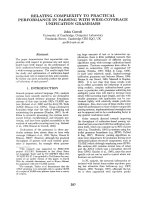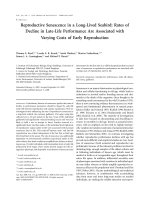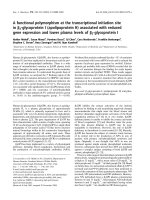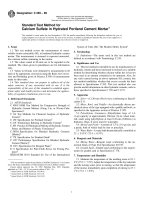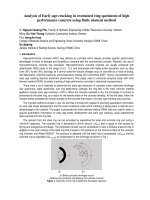UltraHigh Performance Concrete Mixes with Reduced Portland Cement Content
Bạn đang xem bản rút gọn của tài liệu. Xem và tải ngay bản đầy đủ của tài liệu tại đây (527.31 KB, 5 trang )
ISSN 2029–9990
JOURNAL OF SUSTAINABLE ARCHITECTURE AND CIVIL ENGINEERING
DARNIOJI ARCHITEKTŪRA IR STATYBA
2013. No. 3(4)
Ultra-High Performance Concrete Mixes with Reduced Portland
Cement Content
Detlef Heinz, Tobias Gerlicher, Liudvikas Urbonas*
Technische Universität München, cbm Centre for Building Materials, Baumbachstr. 7, D-81245 München, Germany
*Corresponding author:
/>Ultra-high performance concrete (UHPC) usually contains a very high proportion of ordinary Portland cement which
requires a high amount of energy for its production. The present investigations aimed at systematically developing UHPC
produced with supplementary cementitious materials to achieving strengths above 150 MPa at an age of 28 days under
normal conditions or above 200 MPa with heat treatment. The cement was replaced with different amounts of ground
granulated blast furnace slag and fly ash. The effect on the workability of fresh concrete and the evolution of compressive
strength was investigated. A reduction in water and super plasticizer requirement was obtained with these materials.
However, compressive strength decreases with the content of mineral additions. This loss could be partly compensated by
increasing the fineness of the slag or fly ash. It was found that the type and dosage of superplasticizer have a significant
effect on strength development. An appropriate choice of materials enabled the achievement of strengths above 200 MPa
after heat treatment for concrete made with binders containing 25% Portland cement and 75% slag.
Keywords: Binder, Fly ash, GGBS, Mineral additions, UHPC.
1. Introduction
The specimens were demoulded after 24 hours and
either stored in water at 20°C until testing or heat treated
for 24 hours at 90°C (age one to three days) and then
stored at 20°C/65% RH. The heat treated specimens were
investigated before and after heat treatment, i.e. at an age of
3 days, and then at ages of 7, 28, 56, 90 days and 2 years.
The specimens stored in water at 20°C were investigated at
the same ages as the heat treated specimens.
The composition of the young concrete was investigated
in situ seven minutes after water addition and up to the time of
setting using X-ray diffraction. A position sensitive detector
was used with Cu Ka radiation. A scintillation detector was
used for the analysis of powder prepared from the hardened
concrete specimens, (Gerlicher et al. 2009). The silicate
phases were investigated using 29Si‑NMR spectroscopy.
This combined approach enabled the quantification of the
amounts of crystalline and amorphous silicate phases.
Contemporary UHPC is produced with a high content of
Portland cement (DAfStb 2008) whose production requires
considerable amounts of energy. Thus the development of
new UHPC compositions with less Portland cement clinker
is of economical and ecological importance. In the present
investigations, ground granulated blast-furnace slag and
fly ash were used as alternative cementitious materials to
replace Portland cement in the reference mix M2Q. As well
as comparable workability, strengths similar to the reference
mix were required. New mix compositions were designed
based on the knowledge of the hydration of M2Q, the
reactivity of the new components and the packing density of
the particles in the mix as whole.
2. Methods
The packing density of the mixes was determined
according to Schwanda (Schwanda 1966).
The fresh concrete was characterized by measuring
slump flow with the Haegermann cone according to EN
1015-3, but without jolting. The relative yield stress and
viscosity were measured using a rotation viscometer to
provide a better description of fresh concrete workability.
The relative yield stress was determined using the HerschelBulkley Model and the relative viscosity with the Bingham
Model, see (Metzger 2006).
3. Reference Concrete Composition
The M2Q (maximum grain size 0.5 mm) mix was used
as the initial reference composition (Tab. 1).
The phase composition of specimens stored in water
at 20°C and heat treated at 90°C determined by X-ray
diffraction and NMR spectroscopy are shown in Fig. 1.
In the case of the specimens stored in water, it is apparent
47
that the amount of C-S-H increases with age because of the
reaction of silica fume with portlandite. After 28 days the
reaction was still incomplete, cf. Fig. 2.
increase of 67% was determined for the specimens stored
in water at 20°C. Thus without heat treatment more C-S-H
formed over two years resulting in a degree of hydration of
the silica fume similar to that of the heat treated concrete.
After two years more cement had reacted in the concrete
which had not been heat treated, Fig. 2. The measurements
did not reveal a reaction of the quartz components.
Table 1. Reference concrete composition
Constituents
Cement
Silica fume
Water
Superlasticizer
Quartz flour
Quartz sand
M2Q
876
142
187
13
218
985
kg/m³
kg/m³
kg/m³
kg/m³
kg/m³
kg/m³
4. Use of Ground Granulated Blast-Furnace Slag
(GGBS)
Ground granulated blast-furnace slags of different
fineness were used to replace Portland cement in the
reference mix M2Q at 15, 35, 55 and a maximum of
75 vol.%. The effect of superplasticizer type and dosage on
the workability of the fresh concrete and the compressive
strength of the hardened concrete was investigated.
At first, the cement was replaced by GGBS similar in
fineness to the cement (< 40µm). Since the lower surface area
of GGBS requires less wetting than cement and the reaction
of GGBS is slower, slump flow increased considerably
with the amount of GGBS at constant water content of the
mix. Consequently, the water content was reduced to obtain
workability comparable to the reference M2Q, i.e. a slump
flow of approximately 25 cm. This resulted in a reduction
of water/binder ratio. Increasing amounts of GGBS also led
to lower compressive strengths. In the case of the concrete
with 15% replacement, the 28 d compressive strength was
188 MPa, similar to the strength of the reference concrete
stored in water. With heat treatment, the strengths were near
the reference concrete. Heat treatment enabled strengths
above 200 MPa for cement replacement up to 55%, see
(Gerlicher et al. 2008).
The investigations on the phase composition of fresh
concrete up to first setting with in situ X-ray diffraction
showed, as expected, a decrease in the amount of clinker
phases and the formation of ettringite and portlandite.
No change in the amount of quartz flour was apparent.
The amount of portlandite decreased with GGBS content,
(Gerlicher et al. 2009). Even after prolonging the
measurement to 84 hours, no portlandite was present in the
mix with 75% replacement.
60
M2Q
Si content [mol%]
50
40
CEM
CEM_HT
SF
SF_HT
CSH
CSH_HT
Quarz
30
20
10
0
0
7
14
21
28
Age [days]
Fig. 1. Silicate phases in M2Q determined by NMR spectroscopy.
After water storage at 20°C and before and after heat treatment
at 90°C (HT)
Heat treatment accelerated the reaction of the silica
fume to C-S-H which was to a large extent complete after
7 days. In contrast to the specimens stored in water, the
cement did not react appreciably following heat treatment
(age 3 days). At an age of 28 days about 80% of the cement
was still present as unreacted clinker in the concrete.
The amount of C-S-H was observed to increase in the
heat treated concretes by 18% between 28 days and 2 years.
Because of the pozzolanic reaction of the silica fume, an
Fig. 2. Unreacted silicate phases after storage in water at 20°C and heat treatment at 90°C (HT) at ages of 28 days (left) and 2 years
(right). GGBS-35 and GGBS-75 concretes with 35 vol.% and 75 vol.% replacement of cement by GGBS, respectively. HT: heat treated
concrete
48
5. Use of Fly Ash
In investigations on concrete with GGBS, NMR
spectroscopy revealed higher degrees of hydration of
Portland cement at high GGBS contents. A reduction in the
degree of hydration of silica fume due to the production of
less portlandite was also observed (Fig. 2). It is apparent
that heat treatment resulted in a premature standstill of the
GGBS reaction.
Like the reference mix M2Q, heat treatment caused a
rapid reaction of the silica fume in concrete with 35 vol.%
replacement of cement by GGBS (GGBS-35). No further
reaction was detectable after 7 days. Without heat treatment,
the silica fume continued reacting, almost reaching the
strength of the heat treated concretes after 2 years. Both
cement and GGBS in heat treated concretes only reached
a low degree of hydration which barely changed in the
following 2 years (Fig. 2). Like the reference mix M2Q,
more C-S-H was formed after two years if heat treatment
was not applied. The amount of C-S-H in the heat treated
concrete increased by about 11% between 28 days and 2
years. An increase of as much as 80% owing to the reaction
of the silica fume was observed during the same time period
for the concrete stored in water at 20°C.
Even after two years, no appreciable silica fume
reaction was observed for the concrete with 75% replacement
by GGBS (GGBS-75) and not subjected to heat treatment.
Although heat treatment accelerated the pozzolanic reaction,
only 20% of the GGBS reacted, see Fig. 2.
A fine GGBS (< 10 µm) was used in further investigations.
The increased fineness affected the workability and strength
of the concretes. Lower slump flow and higher compressive
strengths were measured (Gerlicher et al. 2008).
The ability of superplasticizers based on
polycarboxylate ether to liquefy the mixes was investigated.
It was found that superplasticizer dosage and type have a
significant effect on strength development. It was possible to
reduce the dosage considerably from 4.2 (SP1) to 1.5 wt.%
(SP2) with respect to cement weight. The low dosage had a
decisive effect on the strength development of the concretes.
With a suitable choice of materials, it was therefore possible
to achieve strengths over 200 MPa after heat treatment with
only 25% cement and 75% GGBS similar in fineness to the
cement (Fig. 3).
The effect of fly ash as a pozzolanic binder component
on the workability of the fresh concrete and the compressive
strength of the hardened concrete was investigated. The
differently reactive constituents of the reference mix were
partly or completely replaced by fly ashes of different
fineness.
It was shown in (Heinz et al. 2009) that the replacement
of cement by fly ash reduces the requirement on water and
superplasticizer of the mix. However, compressive strength
is lower at higher replacement levels. This loss of strength
can be partly compensated by increasing the fineness of the
fly ash. If fly ash is substituted for quartz flour, the fineness of
the fly ash determines the workability of the fresh concrete.
Independent of fly ash fineness, the strength of the reference
mix with quartz flour was achieved.
Based on the results obtained on the substitution of
individual mix components in (Heinz et al. 2009), different
levels of combined replacement were considered by
taking packing density and the chemical reactivity of the
components into account. The two mixes M1F and M2F in
Tab. 2 were designed (Gerlicher et al. 2009a).
Table 2. Composition of Mixes M2Q, M1F, M2F
Composition
Compressive strength [MPa]
250
200
150
100
50
0
7d
M2Q-SP2 GGBS-75- GGBS-75SP1
SP2
28d
7d-HT
M1F
M2F
Cement
kg/m³
876
747
572
Fly ash
kg/m³
0
244
487
Silica fume
kg/m³
142
121
144
Water
kg/m³
187
187
187
Superplast.
kg/m³
13
13
13
Quartz flour
kg/m³
218
0
0
Quartz sand
kg/m³
985
1039
871
In the following, two 4-component systems comprising
cement, fly ash of medium fineness, silica fume and quartz
are considered. The systems are characterized by a reduced
proportion of the energy-intensive materials cement and
quartz flour.
The optimized mixes M1F and M2F exhibited the
same workability properties as the initial mix M2Q.
However, the mix M2F rapidly stiffened after initial good
workability (Fig. 4). Strength decreases with increasing fly
ash content and simultaneous cement reduction (Fig. 5). The
compressive strength of the heat treated concretes was well
over 200 MPa.
Owing to the high cost and scarcity of silica fume, the
replacement of this material is of economic interest. The
partial and complete replacement by processed fly ash (< 10
µm) had been investigated (Heinz et al. 2009). As well as
differing chemically from silica fume, this material is finer
possessing a higher specific surface.
Starting from the reference mix M2Q, 25, 50 and
100 vol.% of the silica fume was replaced by processed fly
ash in mixes SA25, SA50 and SA100, respectively. The
resulting enhanced water requirement of the fly ash concretes
had a pronounced effect on fresh concrete consistency.
300
M2Q-SP1
M2Q
28d-HT
Fig. 3. Comparison of the effectiveness of superplasticizers SP1
and SP2 for concrete adjusted to the same workability and with the
same water content with respect to the binder, i.e. sum of cement
and GGBS. HT: heat treated concretes
49
Despite smaller particle surface areas for wetting, the lower
packing density of the particles worsened workability. To be
able start mixing the concrete with complete replacement at
all, it was necessary to raise the superplasticizer dosage by
39%. This concrete was then, however, high viscous.
30
Relative viscosity
9
Relative yield stress
8
25
Relative yield stress [Nmm]
Relative viscosity [Nmm min]
Compressive strength [MPa]
10
300
7
5
150
100
50
M2Q
7d
SA25
28d
SA50
7d-HT
SA100
28d-HT
15
4
Fig. 6. Compressive strength in dependence of proportion of
silica fume replaced by sifted fly ash, HT: Heat treated concrete
10
3
2
6. Conclusions
5
Owing to the energy intensive production of Portland
cement clinker and its high content in state-of-the art ultrahigh performance concrete (UHPC), the present research
focuses on the reduction of the Portland cement content
of UHPC while maintaining good workability and 28 day
compressive strengths above 200 MPa after heat treatment
at 90°C for 24 hours. Investigations on the effect of binder
composition on workability, the hydration process and
strength development showed that this could be achieved by
the use of ground granulated blast-furnace slag (GGBS) und
fly ash as a binder component.
The replacement of Portland cement by GGBS or
fly ash is shown to reduce the requirement of the mix on
water and superplasticizer. However, compressive strength
also decreases with replacement level. This can be largely
compensated by increasing the fineness of the GGBS and
fly ash.
Although the reduction in Portland cement content
in concretes made with GGBS enhanced the degree of
hydration of the cement, the degree of hydration of the silica
fume was lowered because less Portlandite was available
for the pozzolanic reaction. Apparently, the reaction of the
GGBS came to a standstill after heat treatment.
Investigations with different types of superplasticizer
showed that superplasticizer dosage and type have a
significant effect on strength development. With a suitable
choice of materials strengths above 200 MPa were achieved
with only 25% Portland cement and 75% GGBS after heat
treatment.
Good fresh concrete workability and high strengths
were obtained for separate replacement of cement or
quartz flour by fly ashes of different quality. A combined
replacement of cement and quartz flour also proved
favourable for fresh and hardened concrete properties.
Exchanging silica fume for processed fly ash led
to coarsening of the mix as a whole and, as expected,
deterioration of workability. The production of concrete
with complete replacement of the silica fume by fly ash was
1
0
0
M2Q
M1F
M2F
Fig. 4. Relative yield stress and viscosity of the mix M2Q and the
optimized mixes M1F and M2F
300
Compressive strength [MPa]
200
0
20
6
250
250
200
150
100
50
0
M2Q
7d
M1F
28d
7d-HT
M2F
28d-HT
Fig. 5. Compressive strength of M2Q and the optimized mixes
M1F and M2F. HT: heat treated concrete
Owing to the slow hydration reaction of fly ash, the
strength development of the concretes stored in water at 20°C
became slower with decreasing silica fume content. Thus
the 28 day strength decreased with the fly ash content of the
mix. In the case of the heat treated concretes, the strength
of the reference mix can be reached for replacement up to
50 %. The strength of the concrete completely without silica
fume (SA100) was lower, but still well above 200 MPa. It
should be taken into account that mix SA100 was produced
with a higher superplasticizer dosage which delays strength
development, see Fig. 6.
50
only possible with an increased superplasticizer dosage. It
is possible to reach the strength of the reference mix for
replacement levels up to 50%. Even the strength of concrete
without silica fume was still above 200 MPa.
von ultrahochfestem Beton. In: Proceedings of the 17th
Internationale Conference on Building Materials (ibausil),
Weimar, pp. 02-0596 – 02-0598.
Gerlicher, T., Leonhardt, S., Heinz, D., and Urbonas, L. 2009.
Einfluss des Steinkohlen-flugascheeinsatzes auf die Frischund Festbetoneigenschaften von ultrahochfestem Beton,
In: Proceedings of the 17th Internationale Conference
on Building Materials (ibausil), Weimar , pp. 01–1091 –
01–1098.
Heinz, D., and Gerlicher, T. 2009. Eigenschaften Ultrahochfester
Betone mit zementklinkerarmen Bindemittelsystemen.
Im Rahmen des DFG SPP 1182 Nachhaltiges Bauen mit
Ultrahochfestem Beton (UHPC) / Technische Universität
München.. – Zwischenbericht.
Mezger, T.-G. 2006. Das Rheologie Handbuch, 2. Auflage,
Vincentz Network, Hannover.
Schwanda, F. 1966. Das rechnerische Verfahren zur Bestimmung
des Hohlraumes und Zementleimanspruches von Zuschlägen
und seine Bedeutung für den Spannbetonbau. In: Zement
und Beton, V. 37, pp. 8–17.
Acknowledgment
The investigations were performed in the project
“binder optimization” within the priority programme SPP
1182 funded by the German Research Foundation (DFG) on
sustainable construction with UHPC. The authors thank the
DFG for funding this project.
References
DAfStb-Sachstandsbericht 2008. „Ultrahochfester Beton“ Heft
561, Deutscher Ausschuss für Stahlbeton, Beuth-Verlag,
Berlin.
Gerlicher, T., Heinz, D., and Urbonas L. 2008. Effect of Finely
Ground Blast Furnace Slag on the Properties of Fresh and
Hardened UHPC. In: Proceedings of the Second International
Symposium on UHPC, Universität Kassel, pp. 367–374.
Gerlicher, T., Hilbig, H., and Heinz, D. 2009. Einfluss des
Hüttensandmehleinsatzes auf den Hydratationsverlauf
Received 2013 06 11
Accepted after revision 2013 07 23
Detlef HEINZ – Prof. Dr., Head of Chair of Mineral Engineering at Technische Universität München, cbm Centre for
Building Materials.
Main research area: recycling of secondary raw materials in construction materials, cement – development and application,
concrete additions, durability of mineral building materials, Ultra High Performance Concrete.
Address: Technische Universität München, cbm Centre for Building Materials, Baumbachstr. 7, D-81245 München,
Germany.
Tel.:
+49 89 28927056
E-mail:
Tobias GERLICHER – PhD Sudent at Technische Universität München, Centre for Building Materials.
Main research area: Ultra High Performance Concrete.
E-mail:
Liudvikas URBONAS – Dr., Head of Working Group Binders and Concrete Additions at Technische Universität München,
cbm Centre for Building Materials.
Main research area: cement chemistry, binders with gypsum, durability of mineral building materials, Ultra High Performance
Concrete.
Address: Technische Universität München, cbm Centre for Building Materials, Baumbachstr. 7, D-81245 München,
Germany.
Tel.:
+49 89 28927056
E-mail:
51
